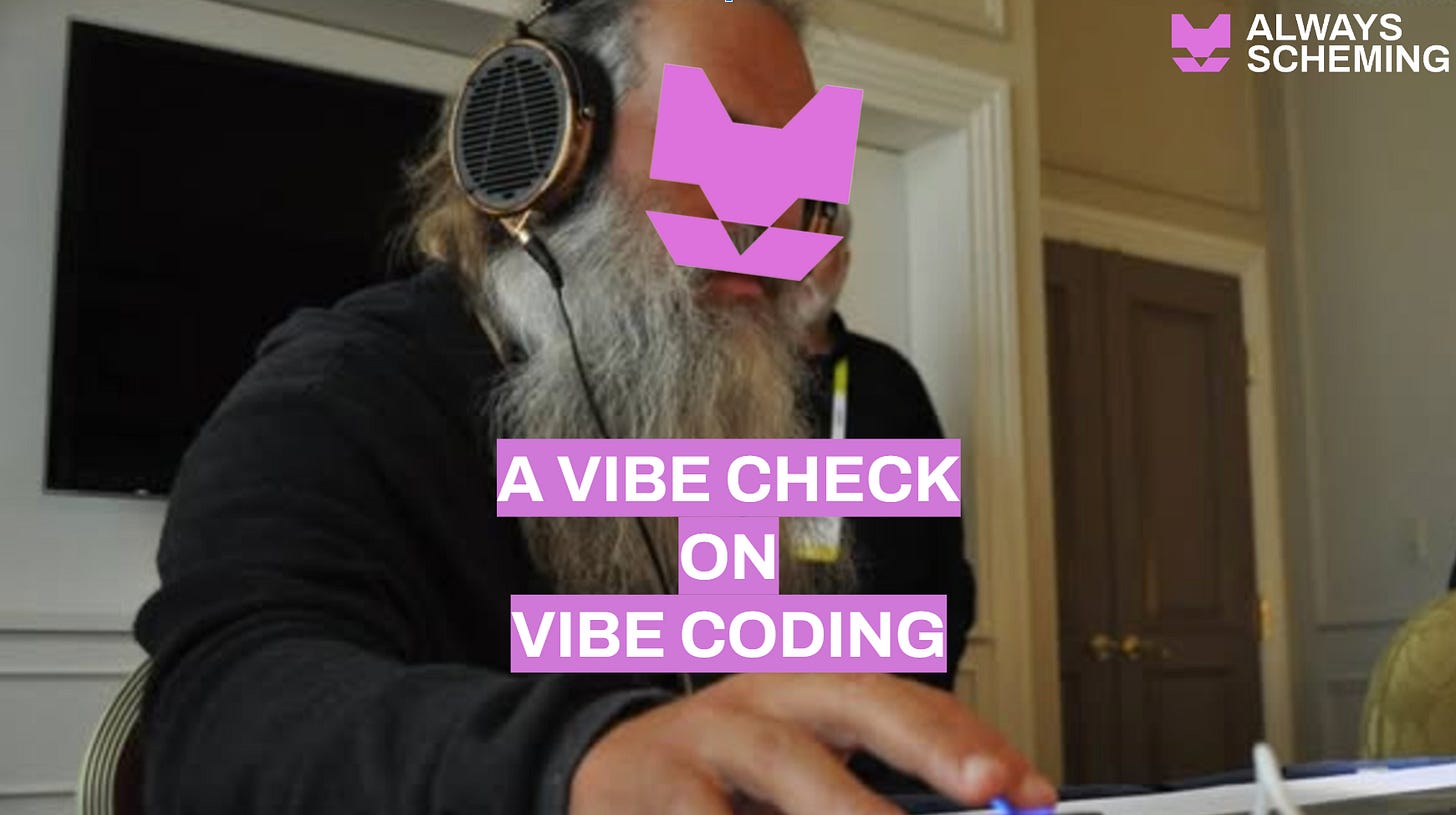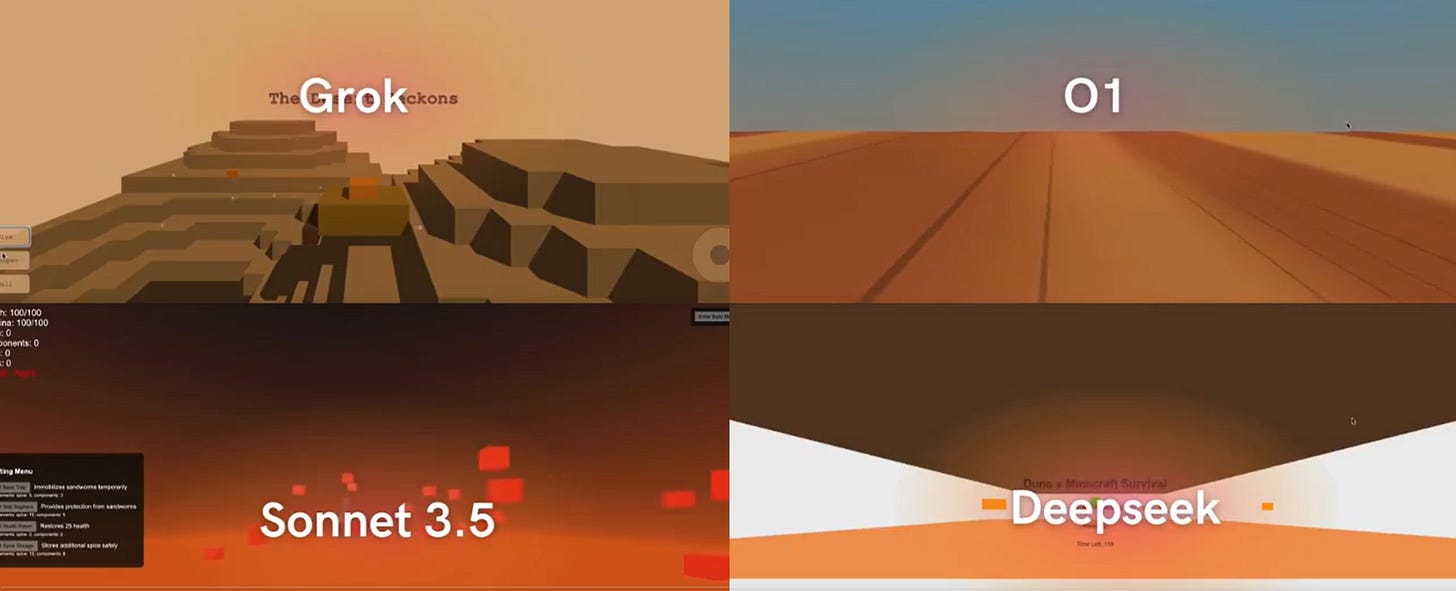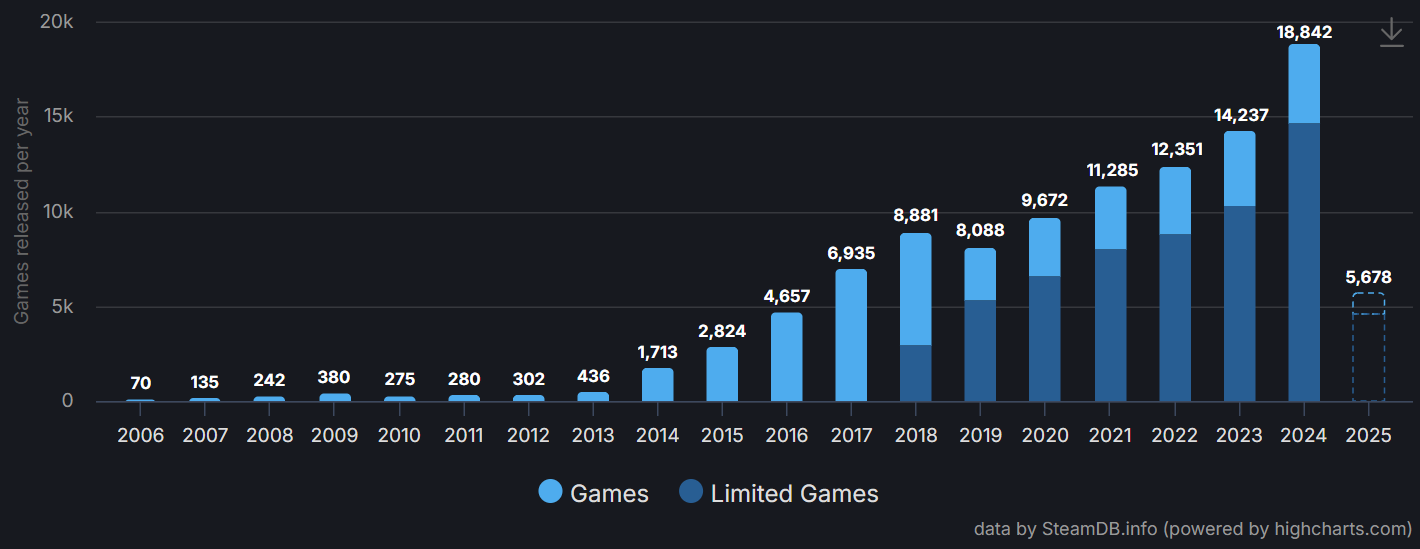A Vibe Check on Vibe Coding
"Vibe coding" is having a moment...but to what end? Can the future of interactive entertainment be swayed by vibes alone?
An open secret of the games industry is that so many of the people working in it — from interns to senior executives — dream of one day making their own games.
Its why we see so many startups focused on content; why so many pitch decks lead with game concepts rather than business models; why the number of new Steam releases breaks records every year.
This is not a recent development. Gaming is fundamentally a passion industry.
What is new is that the distance between creative dreams and tangible realities has never been smaller.
In fairness, these barriers have been steadily falling for the last couple of decades. The historically steep learning curve of game development has slowly been worn down into a smooth-yet-strenuous climb, helped along by increasingly beginner-friendly tools, democratized access to quality instructional materials, and supportive communities of similarly aspirational game makers.
For those willing to put in the time, to learn the tools of the trade (Unity, Blender, RPG Maker, Roblox Studio, UEFN, or any of the countless examples of scaffolding, middleware, UGC frameworks, etc.), the dream was always within reach.
In the end, though, it was always difficult to achieve anything creatively satisfying (let alone commercially viable) without wading into the murky waters of programming.
Generative AI and “vibe coding” are rapidly deconstructing even this most stubborn of obstacles for the non-technical.
“There’s a new kind of coding I call “vibe coding”, where you fully give in to the vibes, embrace exponentials, and forget that the code even exists.”
Andrej Karpathy, Founder, Eureka Labs; co-founder, OpenAI
Source: X
I’ve personally attempted to teach myself programming several times. I’ve bounced off of Codecademy, Replit, edX, and probably half a dozen other pedagogies over the course of my self-directed journey.
In the last few weeks of vibe coding, I’ve been able to translate my creative intent into actual prototypes far faster than I ever would have been able to even six months ago.
In today’s world of constantly expanding technological boundaries, where each day brings news of another novel set of AI tools, the results — rudimentary though they may be — have been truly incredible.
And you know what’s even crazier?
The capabilities (and vibes) are only going to improve.
Vibrate Higher
I won’t bore you with another “How to make the most of AI” self-help post. There are plenty of resources out there if you’re curious to dive in — and you absolutely should.
Rather, I’ll keep the focus of this newsletter on the future implications, as we are wont to do here at Always Scheming. So, to reintroduce this article in the form of a question:
If vibe coding has already arrived today, then what do those vibes portend for the future of interactive entertainment in the next 12 to 36 months?
If we distill vibe coding (and much of generative AI, frankly) down to its fundamental goals, we can describe it as an attempt to translate intents into actions.
Taken to its natural extreme in the context of game development, the holy grail of vibe coding games is probably some form of one-shotting a complete AAA experience with just a simple input. Today, those “inputs” are natural language prompts, but it’s reasonable to assume that that definition could eventually broaden out to include audio, images, videos, or even a visualization in one’s mind, if you want to get really sci-fi.1
We’re not at that point yet, but the progress made in the last several months has been super impressive. Here are a few recent examples of what’s currently possible:
Lisha Li, founder of vibe coding platform Rosebud, showcased the level of quality one can expect using a one-shot concept across several popular LLMs.
Serial entrepreneur Pieter (@levelsio) built this flight sim that pulls in $48K/month (at time of writing).
Here’s another popular flight sim from Nicolas Zullo, making €1,900/month (again, at time of writing).
Matthew Berman created a turn-based space strategy game in just a few hours of vibe coding.
At least this much is clear: that we should expect to see a rapid democratization of the ability to quickly prototype new game concepts. If you’re starting something new, it’s negligent to not at least try running your ideas through a few hours of vibe coding.
If you’ve not yet done any experimentation of your own, I’d encourage you to see how far you can get in an hour with a tool like Rosebud or Cursor. I think you’ll be amazed at what you’re capable of.
Then, imagine how much farther an experienced programmer or game designer would be able to get with a year or two of hands-on vibe coding experience to supplement their existing expertise. The prototyping speed of hyper- and hybrid-casual studios is already insanely fast. Now it will be supercharged.2
Consider also that the tech is constantly being upgraded: LLM context windows are increasing, new models (including fine-tuned, gaming-specific forks) are being developed, training data is becoming more abundant, and best practices are emerging.3
The sheer quantity of content created will skyrocket, with speed to market dropping to near zero. This will have all sorts of knock-on effects:
Discoverability
In a world where the consumer is overwhelmed with choice, discoverability takes center stage.
Players already expect a high baseline of quality and will continue to do so as the backlash against “AI slop” grows in intensity. Taste and aesthetic will be critical to rising above the crowd.
Immersive storytelling, unique worldbuilding, clever game mechanics, unconventional art styles, and other creative differentiators will be the hallmarks of tomorrow’s breakout hits — particularly those without established IPs attached to them.
On the platform side, developers and publishers will place greater pressure on the operators of distribution channels to curate and moderate discoverability. Naturally, the deluge of AI-enabled content will be countered with AI-driven discoverability, kicking off a new competition to see who can best out-maneuver the algorithms.
Attack of the Clones
As the speed of development increases, so too does the ability for fast-followers to seize upon perceived market opportunities.
Anything remotely approaching a hit will immediately be cloned or one-upped. This becomes particularly pernicious when knock-offs begin to appear on platforms where the original was never launched. This was already happening well before vibe coding, of course, but will be further exacerbated by the aforementioned speed-to-market and discoverability challenges.4
On the other hand, increased speed of development will be accessible to everyone, thereby raising the bar for all parties. Perhaps teams will be encouraged to launch on a wider range of platforms from day one in an effort to counteract fast-follows? This seems more likely for titles in the AA and AAA range, where budgets are larger and relationships with platform holders are stronger.
Engines Get in the Game
It seems only a matter of time before vibe coding makes its way to the engine layer. We know that both Unity and Roblox have invested heavily in AI tooling for their ecosystems. Epic and Unreal Engine have been quieter on this front, but the community is already creating plugins to fill the gaps.
The developer community will continue to play a large role in connecting generative AI to game engines. A quick Google (or Perplexity) search shows us that a plethora of MCP servers already exist for use with both Unity and Unreal.5 Enterprising creators will find ways to make their workflows more efficient, connecting a widening array of LLMs to their tools of choice. We may even see AI-native companies like Lindy look to get involved.
Organizational Impact
Within existing organizations, any non-technical operator can and should now be expected to operate in a nearly full self-service capacity: testing out ideas, improving and automating workflows, and iterating on products.
Jordan Carver, Talent Partner at a16z games, has suggested as much, predicting that “[v]ibe coding is about to be a much bigger part of the interview process—regardless of role type.”
This ability to self-serve will only compound as multi-agent workflows become more broadly available. Creators won’t simply be vibe coding, but vibe PMing, vibe QAing, vibe analyzing, perhaps even vibe publishing, too.
You can probably already see where this is going. High-performers will increasingly question the logic of putting these services to work for corporate hegemons rather than starting their own ventures. Why deliver a greater quantum of work for The Man when you are now better equipped than ever to pursue your own interests?6
The companies that navigate this transition deftly will be those that teach their employees how to leverage these tools effectively, that empower their staff to create (not simply execute), that purposefully incorporate input from across the organization.
On the other hand, struggling companies will grasp for ownership of any employee side project, will stifle innovation with bureaucracy, and may even ban the use of AI altogether.
Bad Vibes
We’ve been fairly optimistic in our analysis thus far, but we should not pretend that vibe coding is without its challenges (nor is it without its own set of noteworthy detractors).
It’s easy enough to get started with vibe coding, but building anything with a modicum of complexity can lead to all manner of problems. LLMs will duplicate work, tear out existing code, pursue dead ends, and generally lose the plot of whatever it is you’re trying to build, particularly as a given thread of conversation grows too long.
There are also distribution challenges. Most vibe coded games have been web-based, which is great for simplicity and spinning up a quick build, but terrible for reaching a mass audience or monetizing at scale. This is a contentious topic, as many in the games industry are actively trying to improve the situation for web games in an effort to avoid the standard 30% platform fees of Apple, Google, Steam, et al. For the time being, though, web games remain a risky commercial proposition.
In Conclusion
For those with limited programming capabilities, vibe coding has the capability to be radically transformational.
As long as you have the patience and ability to express your intent clearly in a manner that an LLM can comprehend, the vibes are at your command.
The only real barrier to getting started with vibe coding games is an understanding of the jargon of game design and development — and this, too, can be easily overcome with a few additional questions to your chatbot of choice.
The vibes are definitely shifting.
I hope you’re ready.
…which we definitely do. Not to worry — Always Scheming is currently cooking up a report on neurogaming, which I can assure you is not a work of fiction. Stay tuned.
This is as good a time as any to mention that vibe coding is not going to replace the need for seasoned engineers any time soon. It is far from production-ready and prone to all manner of vulnerabilities. These are solvable problems, though, and the tools (as we’ll soon discuss) are rapidly improving.
Here are a few tips you might find helpful, if you’re just getting started. I’d be happy to share additional thoughts on what I’ve found useful, if there’s an appetite for it. Let me know!
GameDiscoverCo touched on this in a recent newsletter covering the PlayStation storefront. Worth a read!
It’s important to recognize that a16z and other VCs are talking their own book when they make arguments like these. Their incentive is to find more founders to back (i.e. deal flow). They may still be correct, of course, but vibe coding does little to positively impact the historical failure rate of startups. Perhaps exceptions may arise for companies applying GenAI to industries that have historically been slow to adopt new technologies, but that does not apply to gaming.




![The Future Vibes Vol. One – Vinyl (LP, Compilation, Unofficial Release), [r2334319] | Discogs The Future Vibes Vol. One – Vinyl (LP, Compilation, Unofficial Release), [r2334319] | Discogs](https://substackcdn.com/image/fetch/$s_!UBxb!,w_1456,c_limit,f_auto,q_auto:good,fl_progressive:steep/https%3A%2F%2Fsubstack-post-media.s3.amazonaws.com%2Fpublic%2Fimages%2F6148dcf9-9e1d-4c45-badc-f463e1bd10c7_600x600.jpeg)

